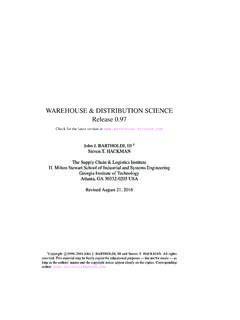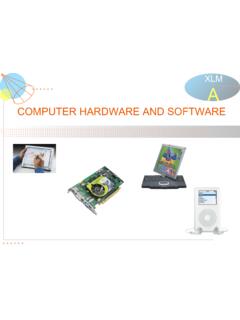Transcription of Chapter 13. Material Handling Systems - gatech.edu
1 Chapter 13. Material Handling Systems This is an introduction Chapter quotation. It is offset three inches to the right. Material Handling Introduction Material Handling Definition Several definitions of Material (s) Handling exist. Materials Handling is defined in Compton s Interactive Encyclopedia as The movement of raw materials, semi-finished goods, and finished articles through various stages of production and warehousing is called materials Handling . Material Handling is concerned with the movement, storage, and control of materials in a (production) process.
2 Material Handling and logistics are expensive operations which comprise of 10 % to 80 % of the product cost and this percentage tends to rise for inexpensive or commodity products. Physical distribution alone, , the movement of products from the manufacturing plants to the customers, accounts for 25 % of the product cost. Internal to the plants, more than 90 % of the product flow time in a job shop is spent in Material Handling functions including waiting for an available machine. 1 Chapter 13. Material Handling Systems Logistics Systems Design Traditional and Modern Views Figure.
3 Material Handling in Early Automotive Assembly The traditional view of Material Handling sees Material Handling operations as non value-adding and only contributing to the cost of the product. As such, Material Handling should be avoided and minimized as much as possible. Since Material Handling operations often involve a substantial amount of direct labor and labor is expensive, many Material Handling design engineers were very supportive of automation. This trend is even more pronounced in Japan and Western Europe where labor is more expensive. The modern view recognizes the space and time utility of Material Handling operations, , a product is worth more if it is at the right place at the right time.
4 The modern goals in Material Handling system design are to create a flexible system that can be used for a variety of products and processes and to integrate the currently designed Material Handling system in the overall Material Handling plan. Stages in Material Handling System Design 1. WHY? 2. WHAT? Logistics Systems Design Chapter 13. Material Handling Systems 2 3. WHEN and WHERE? 4. HOW? 5. By WHOM? Material Handling Classification Classification by Material Material Classes 1.
5 Gasses 2. Liquids 3. Bulk Materials 4. Discrete Load Materials 5. Documents, Mail, and Money 6. Livestock 7. People Unit Load A unit load is very often used in the Material Handling of discrete load materials. A Unit Load is a collection of materials so arranged and restrained that it can be handled, stored, and controlled as a single entity. The advantages of using a unit load are amongst others the uniform Handling and uniform storage operations, the reduced burden on information and control Systems .
6 In addition, unit loads allow efficient (macro) external space utilization since each load is the same size and storage locations can be sized to accommodate this unit load and the loads can be packed tightly together without gaps. The disadvantages of using a unit load are the cost of assembling and disassembling the unit load, the cost of the container and wrapping, and the cost of the empty returnable container Handling or the 3 Chapter 13. Material Handling Systems Logistics Systems Design disposal cost of single use containers. In addition, unit loads can have an inefficient (micro) internal space utilization if the unit loads can be completely filled up.
7 Prime examples of unit loads are a pallet, drum, over the road truck and ocean going intermodal container. The last one is illustrated in Figure Classification by Method Characteristics of Material Handling Methods Table Labor and Control Providers for Material Handling Methods CapabilityLaborControlTypeManualHumanHum anMechanizedMachineHumanAutomatedMachine Machine Table Material Handling Methods Characteristics CharacteristicTypeManualMechanizedAutoma tedWeightLowHighHighVolumeLowHighHighSpe edLowMediumHighFrequencyLowMediumHighCap acityLowMediumHighFlexibilityHighMediumL owAcquisition costLowMediumHighOperating costHighMediumLow FlexibilityCapacityProjectJob
8 ShopFlow ShopManualHardAutomationMechanized &Soft Automated Figure Material Handling Methods Logistics Systems Design Chapter 13. Material Handling Systems 4 Manual Material Handling Figure Illustrations of Manual Material Handling Figure Wheelbarrow as an Example Manual Material Handling Equipment Mechanized Material Handling Figure Fork Lift as an Illustration of Mechanized Material Handling Equipment 5 Chapter 13. Material Handling Systems Logistics Systems Design Automated Material Handling Figure Deep Lane Storage as an Illustration of Automated Material Handling Classification by Equipment Types An extensive taxonomy has been created by the Material Handling Institute of America (MHIA), including drawings of many equipment types.
9 It can be found at Figure Material Handling Equipment Taxonomy by MHIA-CICMHE Pipeline A pipeline is a system of connected pipes for the transportation of liquids, gasses, and slurries. Slurries are fine solid particles suspended in a liquid. Pumps, valves, and other control devices control the flow. Products may be stored temporarily in storage tanks. Pipelines inside the facilities are usually suspended from the ceiling. Pipelines usually consist of sections of pipe made of metals, such as steel, cast iron or aluminum, concrete, or plastics. Pipelines can be used inside the facilities, on campus environments such as chemical refineries, over for long-distance transportation.
10 Please see the section Logistics Systems Design Chapter 13. Material Handling Systems 6 on pipelines in the Transportation Systems Chapter for more information on pipelines used in long distance transportation. Conveyors Conveyors are used when Material needs to be move in a continuous movement over a fixed path. Conveyors have very limited access area and a very high hardware cost and are thus suitable only for very high volume operations. Conveyors can be synchronous or asynchronous. A conveyor is synchronous if all the Material on the conveyor moves at the same time and at the same speed, it is an asynchronous conveyor otherwise.











